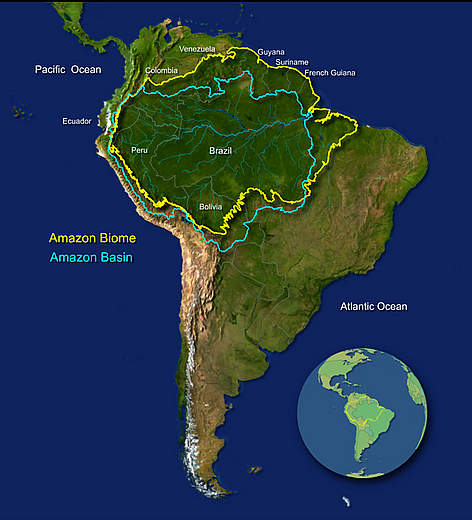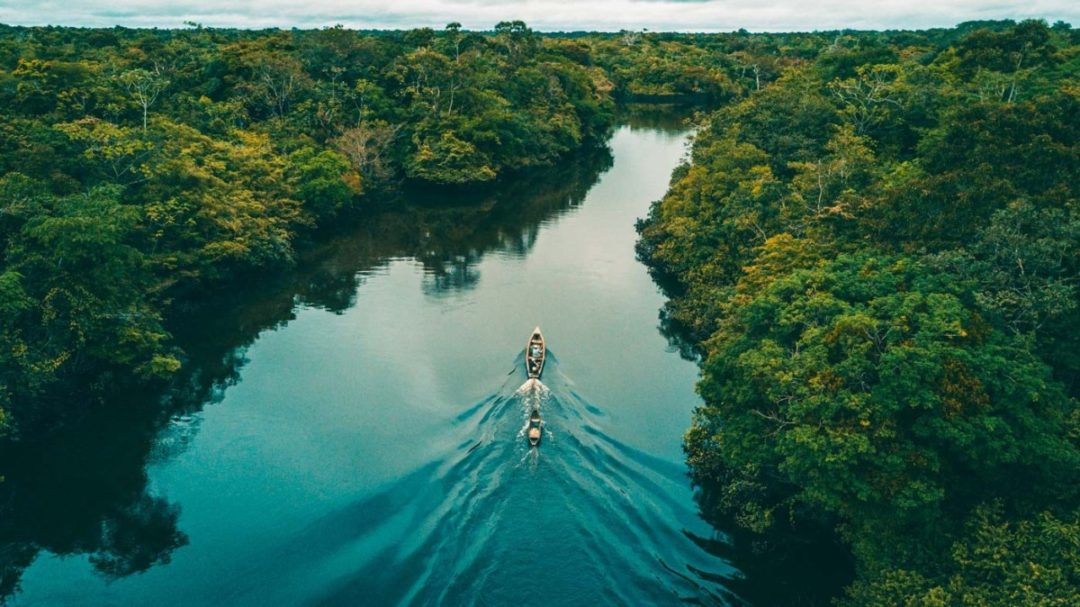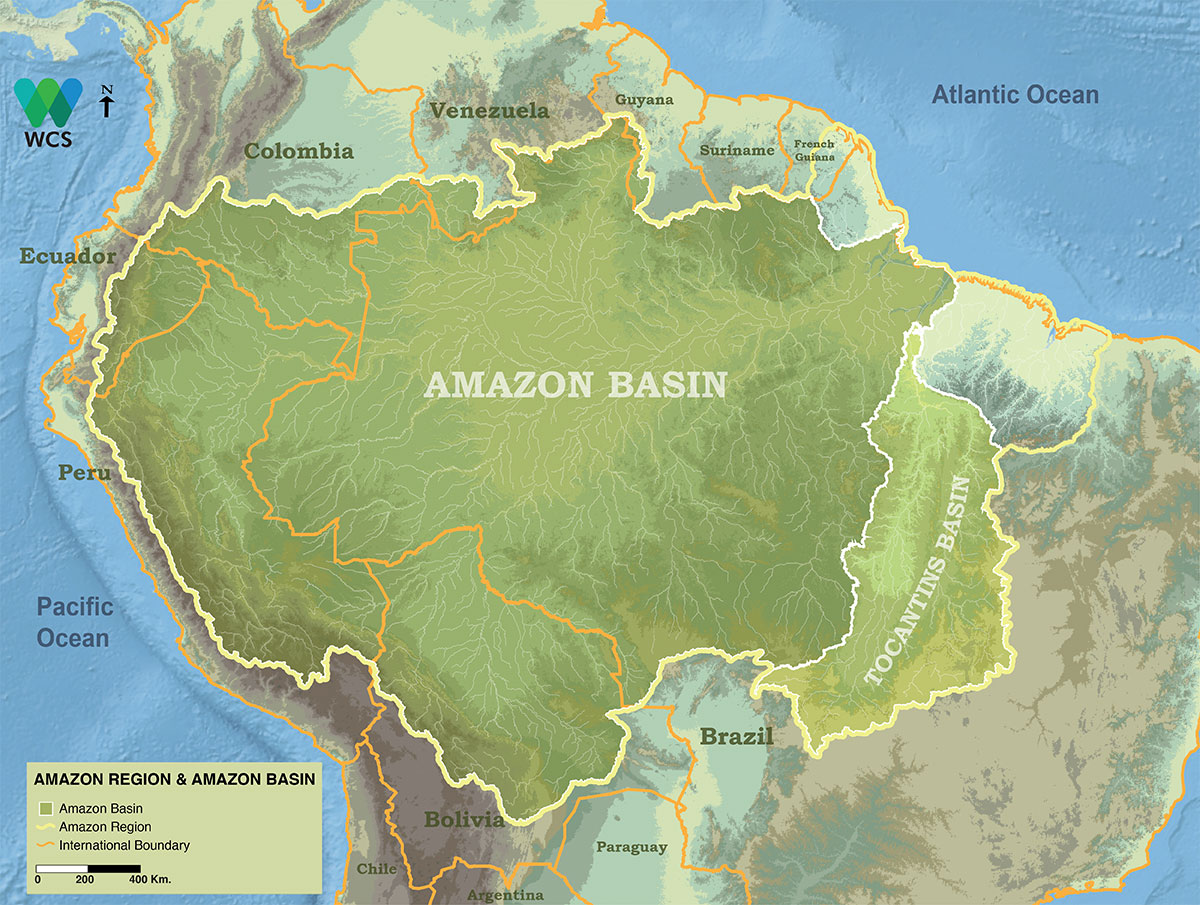What is the Amazon Basin?

Image Source: https://www.thinglink.com/scene/713024997207048194
The Amazon Biome, is defined as the area covered predominantly by dense moist tropical forest which is a a part of the amazon basin. Thus, it can be said that the amazon basin encompasses a variety of landscapes and ecosystems including the tropical forest, savannah river and biodiversity. The Amazon Biome includes relatively small inclusions of several other types of vegetation such as savannas, floodplain forests, grasslands, swamps, bamboos, and palm forests.
The Amazon Biome spans approximately 6.7 million km2 which is twice the size of India. Moreover, it is shared by eight countries (Brazil, Bolivia, Peru, Ecuador, Colombia, Venezuela, Guyana and Suriname), as well as the overseas territory of French Guiana. The complete watersheds expand beyond the biome and sometimes include adjacent biomes (dry forest, cerrado and puna).
It is virtually unrivalled in scale, complexity and opportunity. The amazon basin truly is a region distinguished by superlatives.
Not only does it encompass the single largest remaining tropical rainforest in the world, it also houses at least 10% of the world’s known biodiversity This includes endemic and endangered flora and fauna. The river of the Amazon basin accounts for 15-16% of the world’s total river discharge into the oceans. The Amazon River flows for more than 6,600 km, and with its hundreds of tributaries and streams contains the largest number of freshwater fish species in the world.
Origin of the Amazon River Basin
Millions of years ago, the Amazon River once flowed from east to west, emptying into the Pacific Ocean. When the Andes Mountains began to rise (due to great pressure on the tectonic plates) along the eastern side of the South American continent about 20 million years ago, this emerging mass blocked the flow of the Amazon River.
Freshwater lakes formed as a result, and the flow of the river gradually reversed to its current eastern course. About 10 million years ago, the river reached the Atlantic Ocean, close to the city of Belem in Brazil.
The nature of the Amazon Basin is culturally diversified
As impressive as the largest remaining tropical rainforest,are the profound numbers of mammals, birds, amphibians, and reptiles found across the biome. .Between 1999 and 2009, 1200 species of plants and vertebrates were identified for the first time confirming the Amazon as one the most biodiverse places on Earth.
The Amazon is home to more than 30 million people living across a vast region subdivided into nine different national political systems.
The Amazon’s population is made of approximately 9%(2.7 million). Adding to that, it includes 350 different ethnic groups, more than 60 of which still remain largely isolated. This is according to the Coordinator of Indigenous Organizations of the Amazon Basin (COICA). Yet, for all of its magnitude and apparent remoteness, the Amazon Biome is surprisingly fragile and close to each one of us.
Features of the Amazon River Basin

The Amazon in Peru: Source – https://www.drinkteatravel.com/amazon-river-tour-peru/
The Amazon Basin being humid and warm has all the typical attributes of a tropical environment Temperatures usually average 27.9 °C during the dry season, and 25.8 °C during the rainy season. Relative humidity is quite high at an average of 88% in the rainy season and 77% in the dry season. However, the water cycle is a highly efficient natural process. Every year, the Amazon rainforest receives torrential rainfall – between 1,500 mm and 3,000 mm.
Eastern trade winds that blow from the Atlantic Ocean account for about half of the rainfall, with the other half due to evapotranspiration. Evapotranspiration is the loss of water from the soil by evaporation and through transpiration from plants.
If evapotranspiration and its role in maintaining ecological balance is disrupted, the climate throughout the region and well beyond will be significantly impacted.
Importance of the Amazon Basin
The cover of the Amazon’s canopy helps regulate temperature and humidity. It is intricately linked to regional climate patterns through hydrological cycles that depend on the forests. There is a huge potential to alter global climate given the enormous amount of carbon stored in the forests of the Amazon. This will occur if the climate is not properly stewarded. The Amazon contains 90-140 billion metric tons of carbon, the release of even a portion of which would accelerate global warming significantly. Currently, land conversion and deforestation in the Amazon release up to 0.5 billion metric tons of carbon per year, not including emissions from forest fires. With the forests gone, CO2 is no longer transformed through photosynthesis, and the crops that replace forests only absorb a fraction of CO2 compared to rainforests. Along with industrial pollution, rampant deforestation in South America and elsewhere has significantly increased the amount of CO2 in the atmosphere.This shows that the Amazon is an important factor in regulating global climate.
Article References
- https://globalforestatlas.yale.edu/region/amazon
- https://rainforests.mongabay.com/amazon/
- https://www.encyclopedia.com/environment/encyclopedias-almanacs-transcripts-and-maps/amazon-basin
- https://www.toppr.com/guides/geography/human-environment-interactions/life-in-the-amazon-basin/
- https://www.britannica.com/place/Amazon-Rainforest
- http://wwf.panda.org/knowledge_hub/where_we_work/amazon/
- Main Image Source: http://amazonwaters.org/the-initiative/integrated-river-basin-management/







